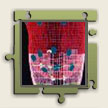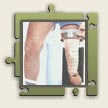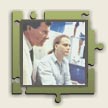Laser Digitizer System for Producing Prosthetic Devices
 People who are without one or more limbs encounter a host of challenges
in their day-to-day lives. Prosthetics serve to make these obstacles a
little easier to overcome by substituting a leg or an arm. Most
artificial limbs require a socket that fits onto the body of a patient;
these are custom-made to fit the individual shape and special needs of
an amputee. Considered to be the most difficult step in creation of a
prosthetic, a socket’s construction requires talented technicians with
skill and experience. Traditionally, sockets for a prosthetic are built
by taking a mould of the body part to form a positive replica. The shape
of the positive is altered to accommodate sensitive areas and increase
the load for other areas such as bony protrusions that are able to take
more pressure. A socket is then built from the positive and attached to
a prosthetic.
People who are without one or more limbs encounter a host of challenges
in their day-to-day lives. Prosthetics serve to make these obstacles a
little easier to overcome by substituting a leg or an arm. Most
artificial limbs require a socket that fits onto the body of a patient;
these are custom-made to fit the individual shape and special needs of
an amputee. Considered to be the most difficult step in creation of a
prosthetic, a socket’s construction requires talented technicians with
skill and experience. Traditionally, sockets for a prosthetic are built
by taking a mould of the body part to form a positive replica. The shape
of the positive is altered to accommodate sensitive areas and increase
the load for other areas such as bony protrusions that are able to take
more pressure. A socket is then built from the positive and attached to
a prosthetic.
George Clynch, president of Clynch Technologies Inc. in Calgary, was
unsatisfied with this method and set out to develop a way of making
better sockets. With help from several institutions including the
University of Calgary and the
Alberta Research Council and
funding from the
Alberta Heritage Foundation for Medical Research and the Workers
Compensation Board, Clynch began work on a digital imaging process in
1974 that would replace the cast and mould system.
Initial tests weren’t as positive as he had hoped. Clynch tried various
methods including ultra sound and MRI, ultimately teaming up with a
California company to develop a non-contact laser scanner and software
specifically for his idea. The end product includes a state-of-the-art
laser camera and is used in practices around the world.
 To begin the process, the patient pulls a cover, in many cases a white
nylon stocking, over the amputated limb. This provides a reflective
surface that will relay measurements and other information into the
laser scanner. Non-reflective markings are placed over the surface of
the stump, on soft spots and bony protrusions that require a
modification to the socket. The limb is scanned and data is presented
digitally so that technicians can alter measurements by increasing or
decreasing the pressure that would be placed on an individual marker. A
code is produced and entered into a cutting machine that creates the
mould for the socket. To begin the process, the patient pulls a cover, in many cases a white
nylon stocking, over the amputated limb. This provides a reflective
surface that will relay measurements and other information into the
laser scanner. Non-reflective markings are placed over the surface of
the stump, on soft spots and bony protrusions that require a
modification to the socket. The limb is scanned and data is presented
digitally so that technicians can alter measurements by increasing or
decreasing the pressure that would be placed on an individual marker. A
code is produced and entered into a cutting machine that creates the
mould for the socket.
 Though this method allows technicians to take the digital images, the
socket is usually not produced on-site. The image is sent electronically to a
central fabrication centre where a specialized milling machine will
produce the apparatus. The socket can be manufactured and shipped out
the same day, arriving back at the original clinic for fitting the next
morning. This central production centre cuts costs and guarantees
quality control. Though this method allows technicians to take the digital images, the
socket is usually not produced on-site. The image is sent electronically to a
central fabrication centre where a specialized milling machine will
produce the apparatus. The socket can be manufactured and shipped out
the same day, arriving back at the original clinic for fitting the next
morning. This central production centre cuts costs and guarantees
quality control.
The laser scanning system has proved to be very successful in the field
of prosthetics, but could potentially be applied to many other medical
specialties such as oncology, plastic surgery and helmet manufacturing.
[<<back]

Copyright © 2003
Heritage Community Foundation All Rights Reserved
|
 Heritage Community Foundation Presents
Heritage Community Foundation Presents





